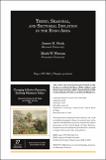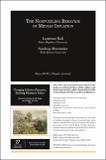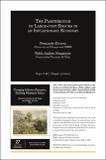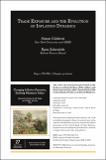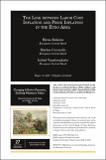Search
Now showing items 1-10 of 20
Trend, seasonal, and sectorial inflation in the Euro Area
A central focus of monetary policy is the underlying rate of inflation
that might be expected to prevail over a horizon of one or two years.
Because inflation is estimated from noisy data, the estimation of
this underlying rate of inflation, which we refer to as trend inflation,
requires statistical ...
The nonpuzzling behavior of median inflation
For decades, textbooks have explained inflation behavior with
Friedman (1968)’s Phillips curve: the inflation rate depends on
expected inflation and the deviation of unemployment from its natural
rate. Yet this theory has always been controversial, and skepticism
has been rampant in the decade ...
The passthrough of large-cost shocks in an inflationary economy
This paper surveys and modestly extends the theory of menu-cost
models of the behavior of the aggregate price level after large-cost
shocks. It does so in the context of an economy with a high underlying
rate of inflation. It concentrates on the effect of large permanent and
unexpected increases ...
Trade exposure and the evolution of inflation dynamics
The Phillips curve—the relationship between price inflation
and fluctuations in economic activity— is a central building block
of economic models that allow for nominal rigidities and are relied
upon by central banks around the world to gauge cyclical inflationary
pressures and forecast inflation. ...
The three E’s of central-bank communication with the public
Central banks used to ask, “Shall we communicate this?” Now, as a rule, they ask, “Why wouldn’t we communicate this?” This
first wave of the revolution in central-bank communication is giving rise to a second wave. The question increasingly is, “How should we communicate this in a way that engages a ...
The transformation and performance of emerging market economies across the great divide of the global financial crisis
Before the Global Financial Crisis, a drive towards greater central-bank autonomy and transparency, as part of the achievement of greater central-bank credibility that had begun in the advanced economies (AE), spread to the emerging market economies (EME). This process was greatly enhanced by the ...
Fiscal inflation and cosmetic defaults in a small open economy
For a small open economy, maintaining a stable exchange rate and moderate levels of inflation is often a goal of primary importance. At the same time, the profession has recognized the tight link between fiscal and monetary policies in determining inflation dynamics. Thus, the goal of a stable exchange ...
The fiscal footprint of macroprudential policy
Monetary policies leave a fiscal footprint. When the central bank cuts the policy interest rate, this footprint comes through multiple
channels: The demand for currency rises, so the central bank prints more banknotes to accommodate it, and this creates seignorage revenues. Inflation unexpectedly ...
Inflation targeting under political pressure
Historically, many emerging economies, particularly in Latin America, battled against persistently high and volatile inflation. Today, emerging economies continue to experience higher inflation than developed ones, and their central banks deviate more frequently from inflation targets. These patterns ...
The link between labor cost inflation and price inflation in the Euro Area
To gauge inflationary pressures, policymakers generally pay close
attention to labor cost developments. A key reason has been the widely
held view that labor cost inflation (i.e., wage inflation adjusted for
productivity developments) is one of the main causes of price inflation.
From a theoretical ...

